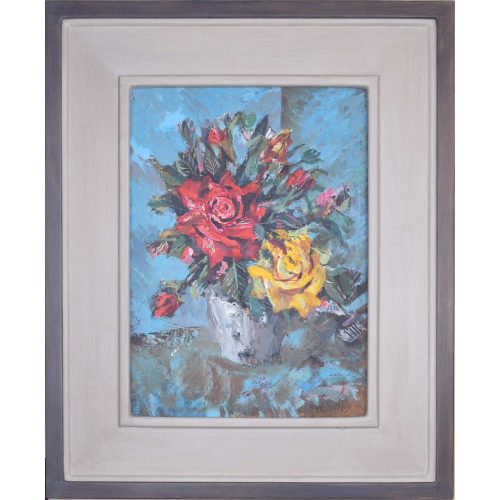-
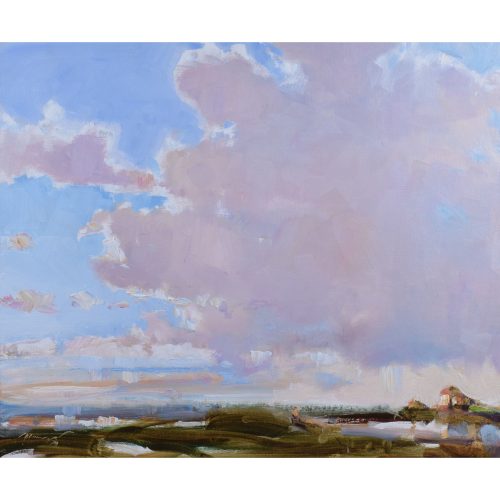
Ken Moroney (British, 1948-) The Fens, Norfolk (c. 1990)
Oil on canvas board 48 x 58 cm Provenance: Bonhams (2003) Of Anglo-Irish parentage, Moroney was born in South London, and showed early artistic talent. His Irish father, finding it unmanly, encouraged him to box, and whilst a teenager Moroney won a gold medal. However this did not distract him from art, and once his boxing hobby came to an end the paints continued to show his flair. Self-taught, his impressionistic style, with bold use of colour, has found widespread favour and his works now hang in many important collections. Here he captures the many colours often visible in a fenland sky, where the flat landscape makes for huge skies. If you are interested email info@manningfineart.co.uk or call us on 07929 749056. Condition: Excellent. -
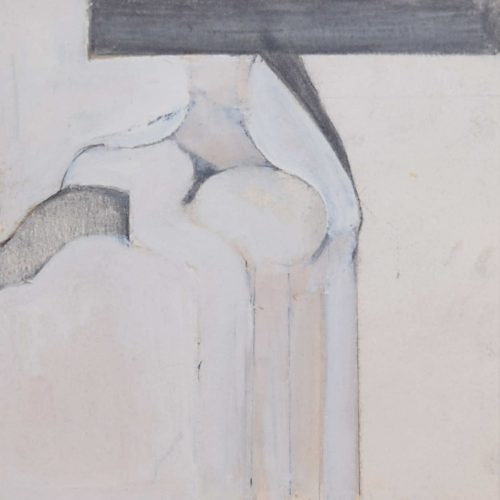
Adrian Heath Abstract Study III (1975)
Acrylic and pencil on paper 22 x 22cm Heath was born in Burma in 1920 and arrived in England aged five. In 1938 he studied art under Stanhope Forbes at Newlyn and later at the Slade School of Art. While serving in WWII, he was captured and placed in a prisoner-of-war camp in Bavaria. Heath attempted to escape from the camp but was recaptured and placed in solitary confinement; this isolation proved crucial to the development of his artistic style, as he spent much of his time there experimenting with abstract forms. When released from confinement, Heath befriended a fellow prisoner of war: Terry Frost. Together they explored the methods of painting which they had developed during their time in the camps, and following the war both became celebrated artists. We have several Terry Frost pieces available too. In 1949 and 1951, Heath returned to Cornwall. He spent time with artists like Ben Nicholson, Victor Pasmore, and Anthony Hill, and became the main link between the emerging St Ives School of artists and the British Constructivist movement back in London. He is further credited with promoting British abstract art through informal exhibitions in his studio on Fitzroy Street, as well as his manifesto-like text entitled 'Abstract Art: Its Origins and Meaning', which was published in 1953. Over time, Heath's paintings of abstract geometry and symmetry became increasingly dynamic and heavily textured, the result of layering paint on paint over the course of several days. This study features a muted colour palette and abstract asymmetric form. If you'd like to know more, please email info@manningfineart.co.uk or call us on 07929 749056. Condition: Good. Signed lower right. -
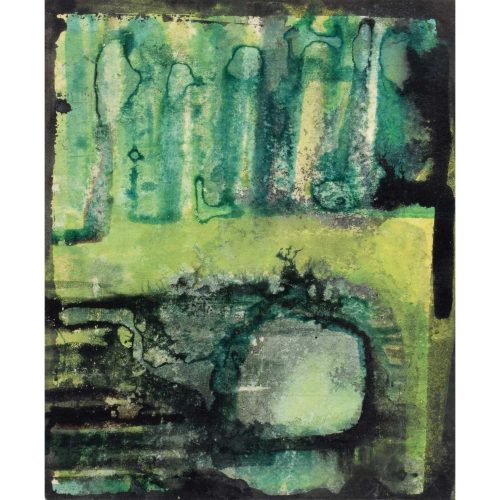
John Piper (1903-1992)
Study for the Piper Building mural
Gouache 14.5x11.5cm Provenance: P Manzareli (who built the fibreglass murals for Piper), gift from the artist; Milne & Moller Fine Art; Katharine House Gallery; private collection, Scotland. This study is a fascinating part of London's architectural history. The Piper Building is a mid-century architectural icon in Fulham. Built in the 1950s as 'Watson House', it was a laboratory complex for the North Thames Gas Board and has an innovative concrete structure. Piper was commissioned to produce the murals surrounding the building. The Gas Board moved out in the mid 1980s. Scheduled for demolition in the 1990s, the building was instead converted into seventy apartments and renamed the Piper Building. With double-height ceilings, the apartments were sold as shells, and purchasers were free to commission their own architects and builders. Condition: Generally excellent; framed. For other works by the artist and biographical details, click here. If you are interested email info@manningfineart.co.uk or call us on 07929 749056. -
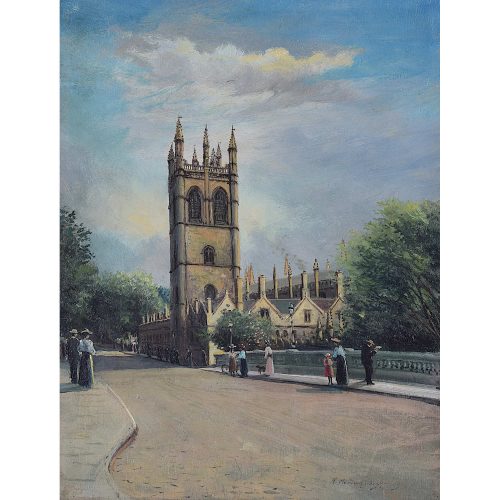
Robert Murdoch Wright (1889-1962)
Magdalen Tower, Magdalen College, Oxford (1910)
Oil on board 35 x 26 cm Signed and dated 1910 Murdoch Wright is best known for his scenes of Egypt, where he travelled and painted widely, see for example this pair sold at Christies. Here he captures Edwardian Oxford with elegantly dressed ladies crossing Magdalen Bridge. Condition: very good; recently cleaned and revarnished. -
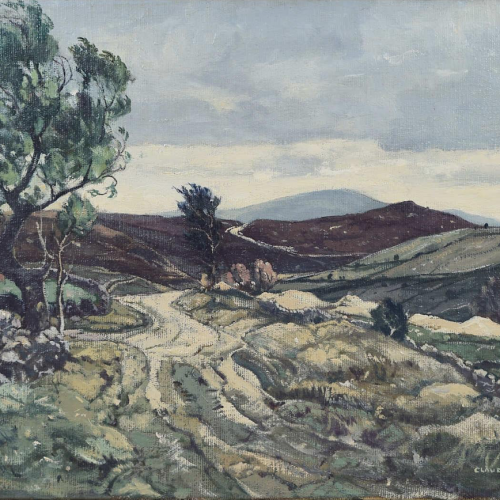
Claude Muncaster Moor above Llangollen
Oil on canvas 36 x 51 cm Condition: Excellent, recently cleaned and revarnished. Signed lower right. Click here for biographical details and other works by the artist. If you are interested, email info@manningfineart.co.uk or call us on 07929 749056. -
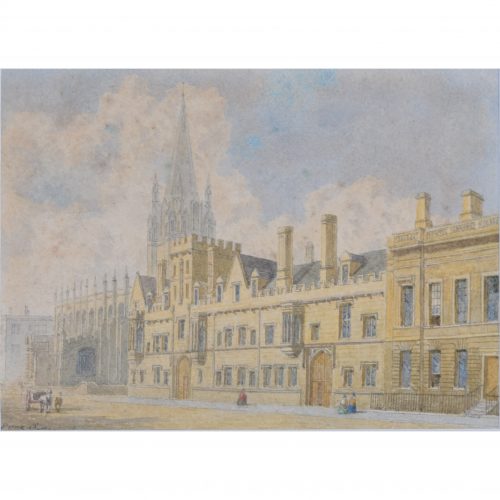
George Pyne (1800 - 1884) The High, Oxford
Watercolour 15 x 21 cm Signed and dated indiscriminately lower left. A 19th-century view of the High Street, Oxford. The spire of the University Church of St Mary the Virgin towers over the street; a horse and cart and brightly-dressed pedestrians pass by. George Pyne was related to two founders of the Society of Painters in Watercolours – William Henry Pyne was his father, and John Varley his father-in-law. Pyne trained as an architectural draughtsman and lived in Oxford from the 1850s until his death in 1884, specialising in views of the city and its colleges. His Oxford pictures are both architecturally-minded and romantically creative, often combining intensely detailed depictions of college buildings with imagined pedestrian scenes. Pyne was also noted for his views of Cambridge and Eton, and for his drawing manuals ‘A Rudimentary and Practical Treatise on Perspective for Beginners’ (1848) and ‘Practical Rules on Drawing for the Operative Builder, and Young Student in Architecture’ (1854); the latter texts offer an insight into his method of depicting architecture and its surroundings. Condition: generally good; some spotting and toning to sky. If you’d like to know more, please email info@manningfineart.co.uk or call us on 07929 749056. -
Out of stock
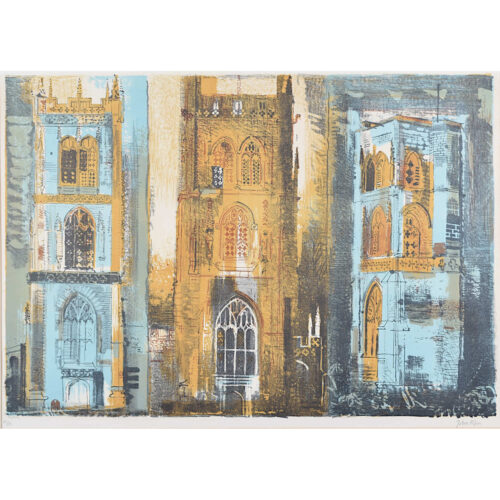
John Piper (1903-1992)
Three Somerset Towers (1973)
Screenprint 56 x 76 cm John Piper CH was an English painter, printmaker, and designer of stained-glass windows. His work often focused on the British landscape, especially churches and monuments, and included tapestry designs, book jackets, screen-prints, photography, fabrics and ceramics. Condition: generally very good; a little age toning. If you are interested, please email info@manningfineart.co.uk or call us on 07929 749056. Click here for other works by John Piper. -
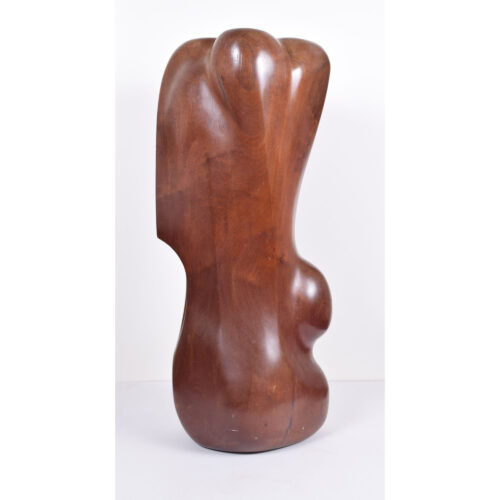
John Robert Murray McCheyne (1911 - 1982)
Metamorphosis (1969)
Polished redwood 96 cm high Provenance: the artist's estate. A significant work by the artist. This sensual mid-century modern nude conveys a sense of monumental abstraction through its sloping curvatures. It swells and recedes, demonstrating not only the sinuous possibilities of the human figure, but also those of the Hepworth- and Moore-influenced abstract form. John Murray McCheyne was a sculptor and teacher. He studied under the sculptor Alexander Carrick at the Edinburgh College of Art between 1930 and 1935. In the 1950s and 1960s he became Master of Sculpture at King’s College, University of Newcastle, and began to work on public sculpture commissions while there. He exhibited at the Palace of Arts' Empire Exhibition Scotland in 1938, and was a regular exhibitor at the Royal Scottish Academy, and the Royal Glasgow Institute. Condition: generally very good; one or two very small scratches. If you are interested, please email info@manningfineart.co.uk or call us on 07929 749056. Click here for other Modern British Sculpture. -
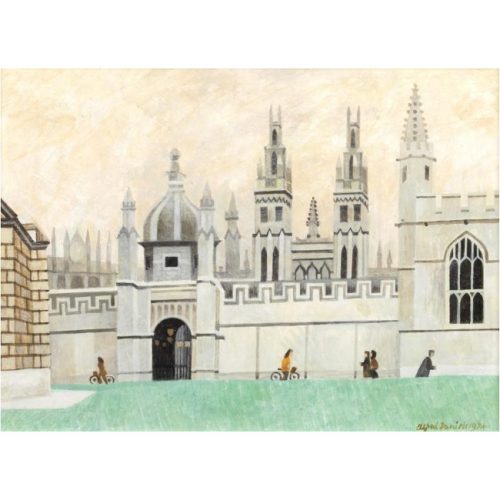 Alfred Daniels RBA RWS (1924-2015) All Souls, Oxford Acrylic on paper In a hand-finished white frame. 22x29.5cm (8.6x11.6 inches) Click here for biographical details and other works by the artist. If you are interested email info@manningfineart.co.uk or call us on 07929 749056.
Alfred Daniels RBA RWS (1924-2015) All Souls, Oxford Acrylic on paper In a hand-finished white frame. 22x29.5cm (8.6x11.6 inches) Click here for biographical details and other works by the artist. If you are interested email info@manningfineart.co.uk or call us on 07929 749056. -
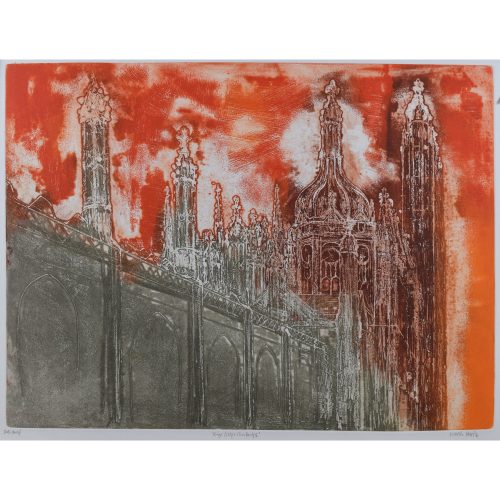
Walter Hoyle (1922 - 2000)
King's College Chapel, Cambridge in red (1965)
Linocut Cambridge Series State Proof, Signed and Titled in pencil. Printed by the artist at Editions Alecto51x69cm Condition: Excellent Click here for biographical details and other works by the artist. If you are interested email info@manningfineart.co.uk or call us on 07929 749056. -

Ethel Louise Rawlins (1880 – 1940)
A Garden Below the South Downs
Oil on canvas51 x 61 cmSigned lower right.Rawlins was a painter who studied at the Slade School of Fine Art and in Newlyn, Cornwall. She settled in Sussex in the early 1920s, and often painted the rolling hills of the Sussex landscape. Here, blue hills and a grey sky serve as the background for an extensive garden complete with stone urns, flowers, and slanting shadows created by the late afternoon sun. -
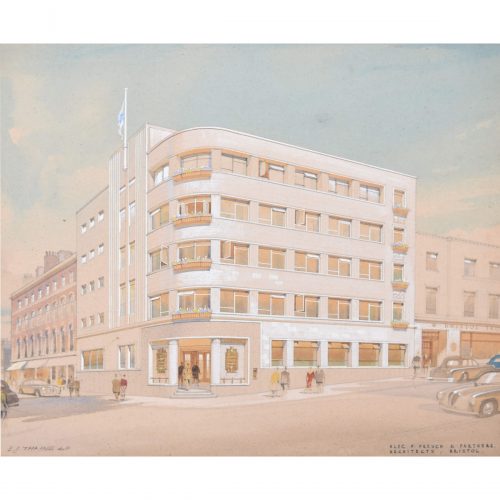
Edmund J Thring (1906 - 1985)
Design for St Nicholas House, High Street, Bristol
Gouache 46 x 54 cm Signed lower left and inscribed 'Alec F French & Partners, Architects, Bristol' (home to the Commercial Union Group and remodelled in 1959 by Alec French and partners). An architectural drawing of St Nicholas House, a 1930s Art Deco building on the corner of St Nicholas Street and High Street in the heart of Bristol. It was originally built as a banking headquarters, and is recognisable for its curved facade. Today St Nicholas House is a co-working space owned by The Office Group; the interiors have been remodelled in an Art Deco-inspired style, in honour of the building's architectural origins. Edmund J Thring was an architectural perspectivist who produced over 2,500 perspectives in his lifetime. He spent much of the Second WorId War in the Photographic Reconnaissance Interpretation Unit at RAF Nuneham Park, interpreting aerial photographs and making models. In 'A History of Architectural Model Making in Britain', David Lund notes that Thring was the chief instructor for the hundred or so recruits in the model-making department. He was described as ‘a sweetly patient man with a merciless eye and inflexible standards of quality’ who pushed his recruits hard. The team made over four hundred models for the D-Day invasion, and a thousand further models over the rest of the war. Pilots bombing German warships in Norwegian fjords found maps almost useless, so carried cardboard models of the topography in their cockpits. Thring also served with the Observer Corps, scanning the English Channel from the Sussex coast. Following the war, he began taking commissions for architectural perspectives (there were plenty of these available on account of the extensive postwar rebuilding works). We are grateful to the artist’s daughter for providing this information. Condition: generally very good, mounted to board, old time-staining to very margins under mount area. If you are interested, please email info@manningfineart.co.uk or call us on 07929 749056. Click here for our other architectural drawings. -
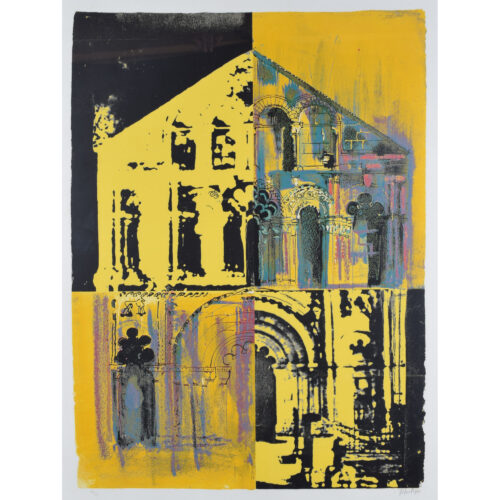
John Piper (1903-1992)
Le Petit Palais (1972)
Screenprint Signed and numbered 18/25 in pencil. Piper's print of the Petit Palais in shades of yellow. The Petit Palais is an art museum in Paris; it was built for the 1900 Exposition Universelle and is now home to the City of Paris Museum of Fine Arts. John Piper CH was an English painter, printmaker, and designer of stained-glass windows. His work often focused on the British landscape, especially churches and monuments, and included tapestry designs, book jackets, screen-prints, photography, fabrics and ceramics. Condition: generally very good; mounted to board. If you are interested, please email info@manningfineart.co.uk or call us on 07929 749056. Click here for other works by John Piper. -
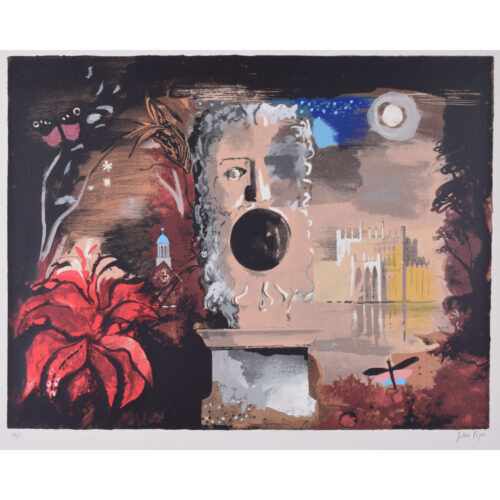
John Piper (1903 - 1992)
Façade (1987)
Lithograph 45 x 60 cm Numbered 96/108 lower left and signed lower right, both in pencil. Printed by Piper and the screenprinter Chris Prater in 1987 after the original designs from 1942. 'Façade' was a sequence of poems written by the English poet Edith Sitwell. They were set to music by William Walton in 1922, four years after they were first written. 'Façade' premiered in 1923 in London, and was praised for its experimental modernist style. The choreographer Frederick Ashton made Façade into a ballet in 1931; Sitwell did not wish her poems to be included, but Walton's orchestral arrangements were used. John Piper was commissioned as set designer for a 1942 performance of Facade in 1942. This lithograph is the design for the performance's curtain; the poetry and music of the performance were played behind the curtain, unseen by the audience. The Gothic house to the right was inspired by Eaton Hall in Cheshire, and we also see a folly, lake, and wood typical of an English country house. The moon, butterfly, and dragonfly lend themselves to the scene's dreamlike aspects, and the mask in the centre of the design highlights the collaborative nature of Façade - a salute to poetry, music, art, and even architecture. John Piper CH was an English painter, printmaker, and designer of stained-glass windows. His work often focused on the British landscape, especially churches and monuments, and included tapestry designs, book jackets, screen-prints, photography, fabrics and ceramics. Condition: very good. If you are interested, please email info@manningfineart.co.uk or call us on 07929 749056. Click here for other works by John Piper. -
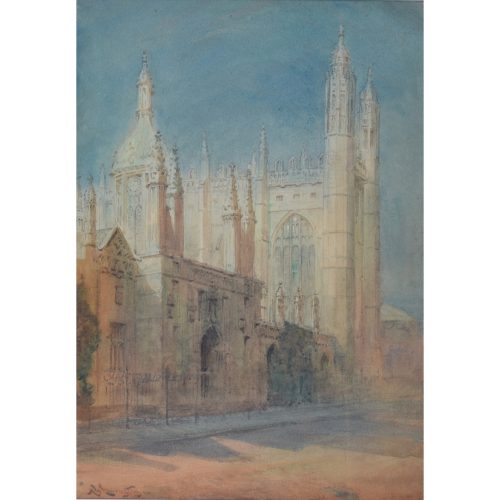
Alexander Wallace Rimington (1854–1918)
King’s College, Cambridge
Signed with initials and dated 1906 Watercolour 33x24cm (12.9×9.4 inches) Alexander Wallace Rimington A.R.E., R.B.A., Hon. F.S.A was Professor of Fine Arts at Queen's College, London. An etcher, illustrator, painter, and author he was most famous for inventing a musical instrument, the 'colour organ' that projected different colours in harmony with music. His first Summer Exhibition at the Royal Academy was in 1880, over subsequent years he exhibited thirty-four works there, mostly topographical works related to his travels around Europe. He had regular shows at the Fine Art Society - seven between 1893 and 1912 - showing a hundred or more watercolours. If you are interested email info@manningfineart.co.uk or call us on 07929 749056. -
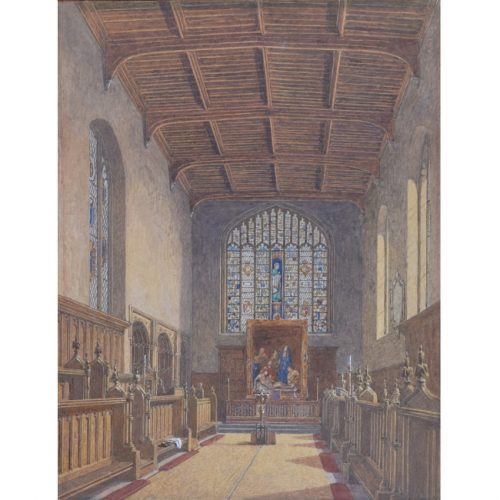
George Pyne (1800 - 1884)
St John's College, Cambridge Old Chapel
Watercolour 35 x 23 cm A view of the Old Chapel of St John’s College, Cambridge before its demolition. In 1861, the Fellows of St John’s agreed to mark the seven hundredth jubilee of their college by building a new chapel. Sir George Gilbert Scott was appointed to carry out the work, and Dr James Wood (a previous Master of the college) bequeathed the huge sum of £20,000 for the purpose of the new chapel. George Pyne was related to two founders of the Society of Painters in Watercolours – William Henry Pyne was his father, and John Varley his father-in-law. Pyne trained as an architectural draughtsman and lived in Oxford from the 1850s until his death in 1884, specialising in views of the city and its colleges. His Oxford pictures are both architecturally-minded and romantically creative, often combining intensely detailed depictions of college buildings with imagined pedestrian scenes. Pyne was also noted for his views of Cambridge and Eton, and for his drawing manuals ‘A Rudimentary and Practical Treatise on Perspective for Beginners’ (1848) and ‘Practical Rules on Drawing for the Operative Builder, and Young Student in Architecture’ (1854); the latter texts offer an insight into his method of depicting architecture and its surroundings. Condition: very good. If you are interested, please email info@manningfineart.co.uk or call us on 07929 749056. Click here for other views of St John's College, Cambridge. -
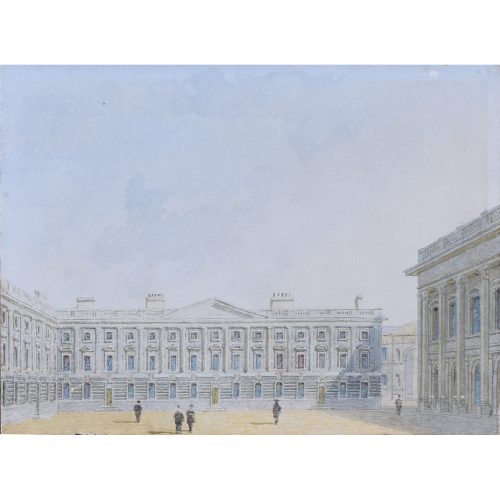
George Pyne
Peckwater Quad, Christ Church, Oxford
Watercolour 13x18cm Click here for biographical details and other works by the artist. If you are interested email info@manningfineart.co.uk or call us on 07929 749056. -
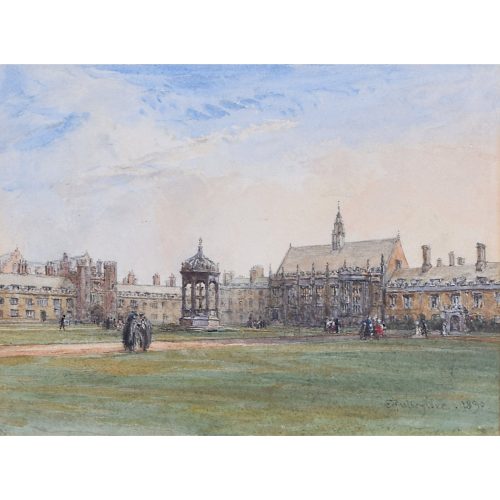
John Fulleylove (1845-1908) Trinity College, Cambridge - Great Court
Watercolour 13x17cm Born in Leicester, John Fulleylove trained as an architect with a Leicester firm before becoming a full-time painter. He exhibited widely in the UK, at such venues as the Royal Academy, the Fine Art Society, and the Royal Society of British Artists. His paintings were the subject of illustrated topographical books, including one on ‘Oxford’ published by the Fine Art Society. If you are interested email info@manningfineart.co.uk or call us on 07929 749056. Condition: Good. -
Out of stock
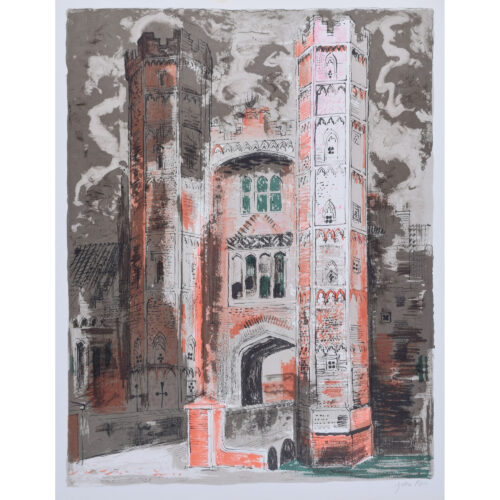
John Piper (1903 - 1992)
Oxburgh Hall (1977)
Lithograph 61 x 48 cm Provenance: Marlborough Galleries. Signed in pencil lower right. Piper's saturnine depiction of Oxburgh Hall, a moated country house in Norfolk now owned by the National Trust. John Piper CH was an English painter, printmaker, and designer of stained-glass windows. His work often focused on the British landscape, especially churches and monuments, and included tapestry designs, book jackets, screen-prints, photography, fabrics and ceramics. Condition: very good; the orange ink is often very faded in the Oxburgh print - this copy remains vibrant. If you are interested, please email info@manningfineart.co.uk or call us on 07929 749056. Click here for other works by John Piper.

